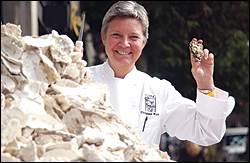The months once more have R’s in them, and oysters are back in season. With the return of oysters to menus everywhere comes the return of one of food-dom’s most venerable sports: patronizing people who prefer their oysters cooked, thank you very much. “Cooked!” say the aficionados of expensive, raw, cold, slithery finger food. “You eat sushi, don’t you? You don’t cook caviar, do you? What are you, squeamish? Come on, try ’em. You’ll like ’em!”
People keep saying this to me, and I keep patiently replying that I have indeed tried ’em, and that I have never liked ’em, any more than I care for other mushy- textured items like pureed vegetables and chicken-liver pâté. Never going on offense, never mentioning that I have noticed that some of the loudest mouths among the raw contingent tend to swallow them whole when they think no one’s looking, while others, who slip their raw morsels in their mouths only after dousing them with lemon juice, salt, pepper, Tabasco, and/or horseradish, have rendered the whole raw-cooked question moot. All I assert is that there is room on the table for cooked oysters, and that a little heat converts a nugget of tang, soon swallowed, to a toothsome morsel of intense flavor and fragrance.
What a pleasure when I find a professional oyster person who is willing not only to tolerate my tastes but to encourage them. Chef Christine Keff’s raw-oyster cred is unquestionable: Her $1 oyster happy hour, a Seattle seafood tradition, returns Tuesday, Nov. 1, to Flying Fish (celebrating its 10th anniversary). But for “Oyster Frenzy,” the real kickoff to the Flying Fish fall season, Keff provides an occasion for rawbies and cooksters, lions and lambs, to belly up to the oyster bar peaceably together—at least for one night (Saturday, Oct. 29).
Keff is not a fan of elaborate oyster recipes, or even simple ones (like “angels on horseback”) which pair a powerful alien flavor with the unique oyster taste. “If you cook an oyster with bacon, you’re going to taste bacon, not oyster. Of course, that’s a plus for people who don’t much like oysters anyway. The same goes for dishes like oysters Rockefeller [which heavily features chopped spinach]. I think I’ve enjoyed that dish once in my life.
“I have no objection to smoking oysters. Our oyster sauce for salmon [a Keff invention] starts with smoking the oysters over a wood fire and then pureeing them with canned chipotle peppers in a beurre blanc.”
In that recipe, the oysters cook fully while they smoke, but for most dishes, Keff recommends minimal cooking—just enough heat to firm up the meat without curdling it into graininess. “That’s why when some people make oyster stew, they don’t add the oysters to the oyster liquid and milk and cream and vegetables until just before serving.” The oyster just poaches lightly in the hot bisque on its way to the table. (Stew is one oyster dish where home cooks have an advantage over restaurants. Keeping a mixture containing milk piping hot without developing a disagreeable “skin” is so tricky that most professional cooks leave the milk out, making for a heavenly tasting but cloyingly rich brew.)
Stew is also a dish that’s a little more forgiving than most unadorned oyster presentations. “My mother used to use a little bacon fat to enrich hers,” says Keff, “and there’s no reason you shouldn’t use preshucked oysters to make it. The results are just as good.” Preshucked oysters, in fact, have many advantages, not least their lower cost. The abundant liquid they’re packed in is a plus for home stew makers, and their uniform size makes consistent cooking much easier. Keff also recommends stark simplicity for pan- or deep-frying. “You can dip them in egg and breading for pan frying, but all you really need is lightly seasoned flour. You need breading if you’re going to deep-fry them, but plain cornmeal does a beautiful job.”
Is there one variety of oyster that’s preferable to others for cooking? “Not really,” says Keff. “The place where the particular variety matters most is when you’re grilling, because the oyster is served in its own natural juice. This is where the quality of your product counts for most—not just which kind of oyster, but how they’ve been handled. You have to be good to them from the moment they come out of the water.”
Oyster Frenzy: all-you-can-eat raw and cooked oysters, 1–4 p.m. Sat., Oct. 29. Oyster Happy Hour: fresh local oysters $1 each, 5–6 p.m. weekdays beginning Tues., Nov. 1. Flying Fish, 2234 First Ave., 206-728-8595, BELLTOWN. www.flyingfishseattle.com. Call for reservations.








